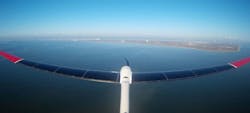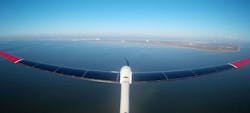Solar Soaring, an energy-harvesting technology developed by the U.S. Naval Research Laboratory (NRL), enables unmanned aerial vehicles (UAVs) to handle longer flight times without heavier batteries. By drawing power from the sun and the atmosphere, UAVs with Solar-Soaring technology can fly for more than 12 hours without carrying extra weight in batteries.
“One of the common complaints that we hear across industry and the warfighters is that they want aircraft to fly longer,” says Dr. Dan Edwards, senior aerospace engineer in NRL’s Tactical Electronic Warfare Division. “One great way to do this is to capture atmospheric wind energy or solar energy to extend the endurance.”
Edwards explains that by using thermals in the manner of a bird in flight, a UAV can use the heated air to gain altitude and save energy: “Sunlight heats up the surface of the Earth, which in turn heats the lowest layer of air. That warm air eventually bubbles up as a rising air mass called a thermal, which the airplane can use to gain altitude.” Solar cells on the UAV are also used as energy sources to recharge the UAV’s onboard battery cells.
Solar Soaring is a combination of techniques applied by the NRL to extend the flight times of UAVs. (Courtesy of the Naval Research Laboratory)
Improvements in solar-cell technology have made the energy sources efficient enough to justify adding their weight to a UAV. “For a long time, even though there has been solar aircraft since the 1990s, the efficiency of the solar cells wasn’t high enough to pay the mass penalty, meaning you weren’t getting enough energy to justify the additional mass,” says Phil Jenkins, head of the Photovoltaics Section in NRL’s Electronics Science & Technology Division. “But over the last 10 years, that has really changed. The cells have gotten more efficient and lighter.”
This combination of technologies, which NRL refers to as “Solar Soaring,” is enabling long-distance surveillance missions for UAVs and many other longer-duration applications once considered not possible because of limited battery life. “In the case of Solar-Soaring, we’re demonstrating the techniques to fly aircraft with a higher endurance,” says Edwards. “These techniques are portable to a lot of the programs of record, like the small-size Raven or potentially the larger Predator, so it’s a pretty broad application space.”
About the Author
Jack Browne
Technical Contributor
Jack Browne, Technical Contributor, has worked in technical publishing for over 30 years. He managed the content and production of three technical journals while at the American Institute of Physics, including Medical Physics and the Journal of Vacuum Science & Technology. He has been a Publisher and Editor for Penton Media, started the firm’s Wireless Symposium & Exhibition trade show in 1993, and currently serves as Technical Contributor for that company's Microwaves & RF magazine. Browne, who holds a BS in Mathematics from City College of New York and BA degrees in English and Philosophy from Fordham University, is a member of the IEEE.


